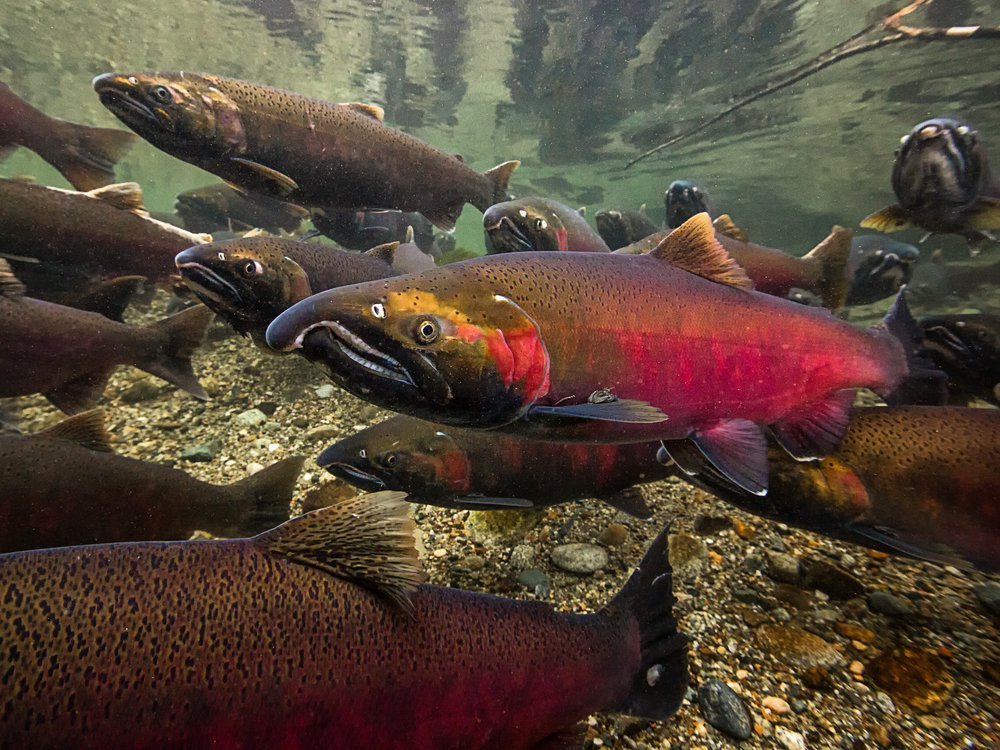Threat of Human Intervention on Pacific Northwest’s Keystone Species: The Salmon
Coho salmon, a species of wild Pacific salmon in danger of extinction (Jess Newley)
By Kaya Zhou
Stunning coastlines and luscious forests are a trademark of the Pacific Northwest, providing homes and sustenance to its abundant wildlife. Salmon enrich and nourish the land by bringing in marine nutrients from the ocean, from which over 137 different species benefit (Wild Salmon Center, 2021). Salmon also have a vital stake economically, as pacific salmon drives a billion-dollar industry which supports thousands of jobs to local communities in the Pacific Northwest (WSC, 2021). This species of fish has played an imperative role in the culture of First Nations that call the Pacific Northwest home; they are the inspiration behind many dances, festivals, and dishes to the tribes. However, with the increase of human activity in the region, specifically the development of the logging industry, comes the impending threat to the salmon population, and consequently danger to local cultures and communities.
Salmon hold great cultural significance to First Nation communities of the Pacific Northwest. It is a staple in their diet, and an inspiration to ceremonies and art forms (Macgillivray). Zachary Sherker, a contract biologist and phD candidate at the University of British Columbia explains the importance of salmon to first nations of the Pacific Northwest, as reflected in their respectful fishing methods: “Over millennia, the aboriginal populations have preserved the fish through smoking, and devised different types of fish traps where they could selectively fish” Sherker elaborates. He points to the difference in comparison to industrial fishing methods such as gillnetting, which are much more wasteful and harmful to the ecosystem. Fishing practices adopted by the First Nations focus on conservation, with traps allowing for excess salmon to escape and avoiding harm to other forms of marine life.
However, habitat destruction in the form of heavy logging in recent years has been a driving force behind the dwindling population of wild salmon, devastating to many First Nation communities of the Pacific Northwest. In the past decade, the Pacific Northwest salmon population has drastically decreased, with only roughly 283,000 sockeye salmon returning to the Fraser region, while close to 20 million returned in peak years (Rasmussen 2020). There are 20 populations of wild salmon currently identified as threatened in the Endangered Species Act, and salmon are now extinct in 40 percent of their historical range (Long 2014). This decline severely affected the economic and social development within Aboriginal communities, as many of them relied on fishing as a means of sustaining and providing for their families; after decades of lawsuits and protests, the Canadian government were pushed to act in the 1990s to improve Indigenous participation in commercial fishing (Macgillivray 2018). In 2009, the federal government officially recognized the rights of First Nations to hunt and sell fish in their territories within a certain distance from shore (Macgillivray 2018). However, the damage done to the salmon population after a century of habitat destruction in the Pacific Northwest was evident.
It should also be taken into account, the extent to which society can afford to consider the cultural significance and environmental importance of a species, at the expense of economic development. Many members of the working population depend on the timber industry for sustenance — softwood log exports hold a major stake in international products trade from the Pacific Northwest (Daniels 2005). However, the devastating effects of the timber industry on the salmon population are undeniable. Sherker researched the impact of small-scale barriers for freshwater development, on salmon populations in the region, finding that certain road structures known as culverts are put in streams to construct forestry roads. “These corrugated metal pipes that can be 60 ft wide or more to build forestry roads on top” Sherker explains, “over years these pipes constrict water flow; the fish end up having to jump over 5-ft to get over the barrier”. Sherker emphasizes that up to 30 percent don't pass fish, and this is detrimental because a stop of even a couple days is harmful to salmon trying to get back to their natal streams because they do not eat during the journey. The logging industry also alters the natural temperature of salmon habitat as tall forests provide shade to streams where salmon thrive, and deforestation has increased the temperature of salmon habitat (Ficke et. al 2007). As cold-water fish, salmon are sensitive to changes in water temperatures (Spain and Helliwell, 2016). Moreover, deforestation increases soil erosion leading to landslides which can suffocate juvenile salmon (Spain and Helliwell, 2016).
There have been efforts to counter these detrimental effects, with billions of taxpayer money being spent on salmon restoration, however with little success. These measures were often employed too late, such as with the Endangered Species Act in Oregon, which only stopped Coho harvest after the population had dwindled to less than 3% of their historic abundance (Rahr). Moreover, more money has been dedicated to improving symptoms of salmon population decline rather than addressing the causes; there have been efforts spent on temporary fixes, such engineering stream habitat by placing logs, though these measures do not last in the long-term (Rahr). This has all had a detrimental impact on the First Nations who call the Pacific Northwest home, as they are impacted economically as well as socially, no longer able to rely on fishing as a means to sustaining their families and keeping alive their traditions. In order to protect this keystone species, and preserve their cultural significance to the Pacific Northwest, addressing the root issue of the logging industry is imperative.

